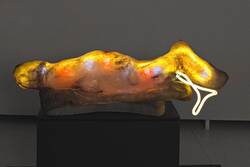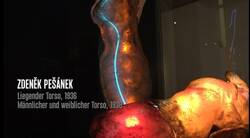This internationally little-known pioneer of kinetic art created innovative light-kinetic sculptures, experimenting with moving images and light, industrial neon, and the medium of film. From 1920 he was a member of the left-wing Association for Modern Culture, Devětsil. He also explored the role of light in art at a theoretical level in his book Kinetismus (Kineticism), which, after failed attempts at publication in the 1920s, was only published in 1941 (when it went unnoticed). Owing to the nature of his works, which were often created as architectural elements, few of them have survived to the present day.
Probably his best-known work is his colour piano, which the artist called a Spectrophone and which combines light, colour, and sound. Similar experiments had been known about since 1912, when the Russian avant-garde painter Wassily Kandinsky published his musical composition The Yellow Sound, which combined music and colour. In 1930, Pešánek had the first kinetic sculpture in a public space set up in the Edison transformer substation on Jerusalem Street in Prague. Its transparent plastic body was illuminated by 420 coloured light bulbs. The rhythmic play of light was controlled by a programmable pneumatic piano. However, only six years later this work of art had already disappeared.
In the second half of the 1930s, Zdeněk Pešánek developed new light-kinetic ideas in his design of a Spa Fountain for the Czechoslovak pavilion at the Exposition Internationale des Arts et Techniques dans la Vie Moderne held in Paris in 1937. Only two fragments from this large-scale project have survived,
the standing Male and Female Torso (1936) and the reclining Female Torso (1936), which are now regarded as autonomous sculptures, outside their original context. They epitomise Pešánek's complex approach to the work of art and fundamentally re-evaluate figurative sculpture, whose predominant material had hitherto been marble, bronze, wood, or fired clay. The interior of the translucent Male and Female Torso, made of plastic, is connected by a neon tube, with the neon here representing the passion of a vibrantly bubbling spring. The Spa Fountain thus clearly alluded to the Garden of Eden.
The sound-and-colour experiments of Zdeněk Pešánek are brought to life in this exhibition by the monumental spatial installation created by Magdalena Jetelová, who uses music and its sound vibrations to dissect the rays of light reflected on the wall, similar to the way Pešánek “laid out the octaves of the
piano and (...) assigned colours to them. His colour piano then projected the colours produced by the notes onto relief-like objects.” The light sculptures produced by Krištof Kintera and the kinetic objects of Jakub Nepraš are likewise reminiscent of avant-garde objects created by their early predecessor.
RECLINING TORSO, 1936
MALE AND FEMALE TORSO, 1936
b. 1896 in Kutná Hora / Kingdom of Bohemia
d. 1965 in Prague

